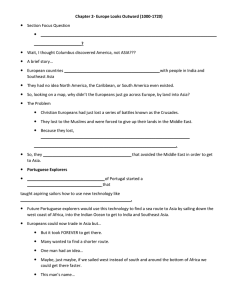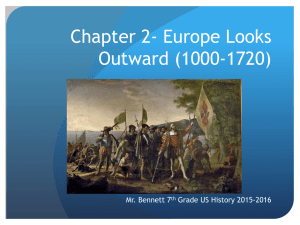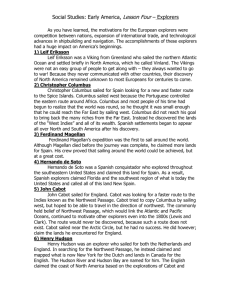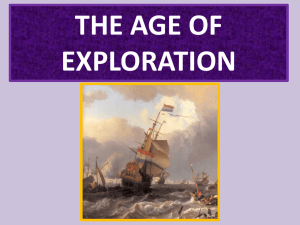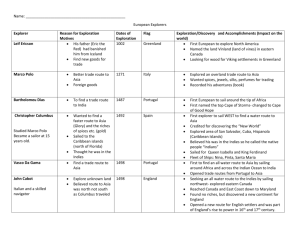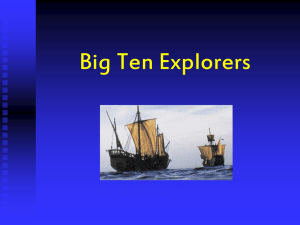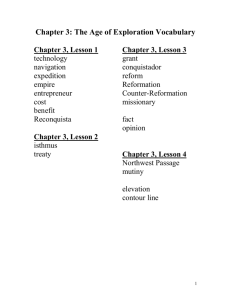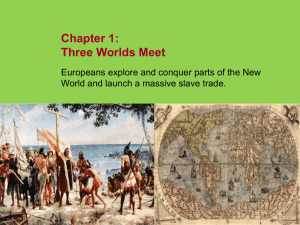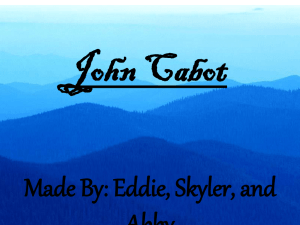Motives for Exploration of New World by Europeans
advertisement
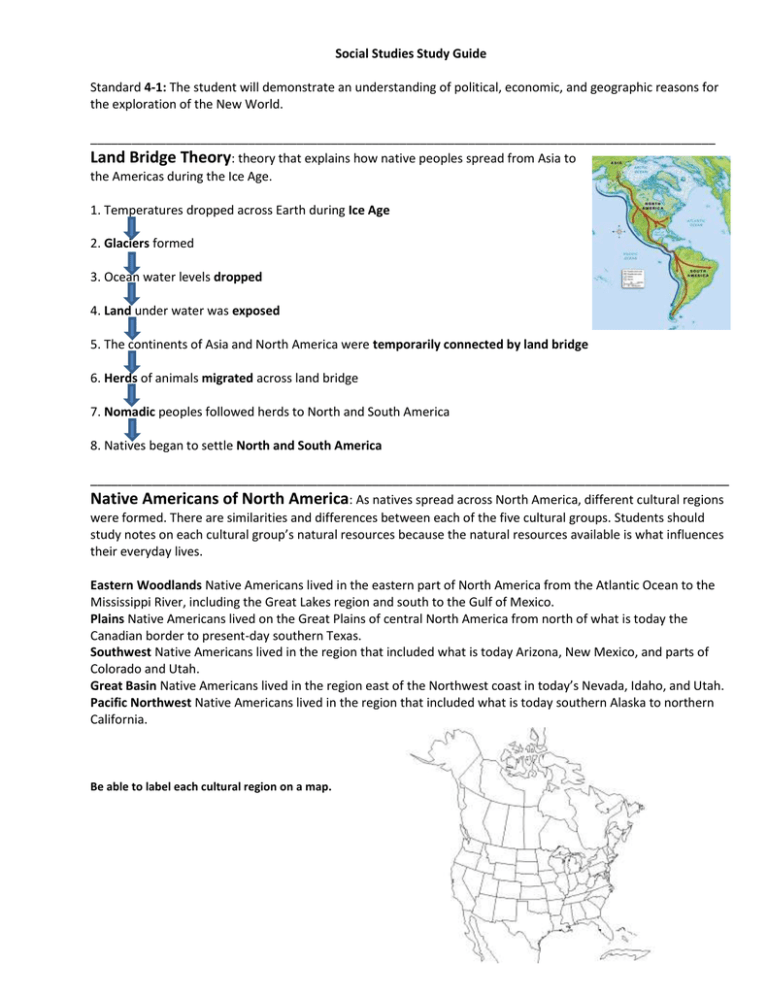
Social Studies Study Guide Standard 4-1: The student will demonstrate an understanding of political, economic, and geographic reasons for the exploration of the New World. ___________________________________________________________________________________________ Land Bridge Theory: theory that explains how native peoples spread from Asia to the Americas during the Ice Age. 1. Temperatures dropped across Earth during Ice Age 2. Glaciers formed 3. Ocean water levels dropped 4. Land under water was exposed 5. The continents of Asia and North America were temporarily connected by land bridge 6. Herds of animals migrated across land bridge 7. Nomadic peoples followed herds to North and South America 8. Natives began to settle North and South America _____________________________________________________________________________________________ Native Americans of North America: As natives spread across North America, different cultural regions were formed. There are similarities and differences between each of the five cultural groups. Students should study notes on each cultural group’s natural resources because the natural resources available is what influences their everyday lives. Eastern Woodlands Native Americans lived in the eastern part of North America from the Atlantic Ocean to the Mississippi River, including the Great Lakes region and south to the Gulf of Mexico. Plains Native Americans lived on the Great Plains of central North America from north of what is today the Canadian border to present-day southern Texas. Southwest Native Americans lived in the region that included what is today Arizona, New Mexico, and parts of Colorado and Utah. Great Basin Native Americans lived in the region east of the Northwest coast in today’s Nevada, Idaho, and Utah. Pacific Northwest Native Americans lived in the region that included what is today southern Alaska to northern California. Be able to label each cultural region on a map. Motives for Exploration of New World by Europeans: There were economic, political, and technological motivations for Europeans to begin exploring the New World (North America). Economic Motivations- The expansion of International Trade: Europe wanted to have access to Asian goods without having to go through a middle man (merchants). Portugal was the 1st country to explore a water route to Asia by sailing west. Spain followed after Portugal, then England also sailed west in search of the Northwest Passage (a water route to Asia that did not exist). Political Motivations- Countries began competing for resources found in the New World. After England and other European countries heard that Spain found gold, silver, and other goods, more countries became interested in exploration. Whichever country was the wealthiest had the most power. Technological Factors- Technology began to increase during this time. Caravel- a smaller and faster ship with triangular sails that could sail into the wind Astrolabe- instrument that measures the height of the sun above the horizon Compass- tells direction; north, south, east, west Astrology advancements- reading of the celestial stars aided sailors in plotting their location and course Cartography- map making skills. Helped them to share their knowledge with others and was taught at the Portuguese School of Navigation. European Explorers: Be able to tell where they came from and major accomplishments Leif Eriksson- Leif Eriksson was a Viking from Greenland who sailed the northern Atlantic Ocean and settled briefly in North America, which he called Vinland. The Vikings’ combative relationship with other Europeans however, did not allow them to share their discovery, so North America remained unknown to most Europeans. Christopher Columbus- Christopher Columbus sailed for Spain looking for a new and faster route to the Spice Islands. Columbus sailed west because the Portuguese controlled the eastern route around Africa. Columbus believed the world was small enough that he could reach the Far East by sailing west. [Columbus was not the first person to believe the world was round. Most educated people of this time held this belief. This is a common misconception.] Columbus did not reach his goal to bring back the many riches from the Far East. Instead he discovered the lands of San Salvador- West Indies and wealth. This provided the gateway of Spanish settlements in North and South America. Hernando de Soto- Hernando de Soto was a Spanish conquistador who explored throughout the southeastern United States and claimed this land for Spain. As a result, Spanish explorers claimed Florida and the southwest region of what is today the United States and called all of this land New Spain. Ferdinand Magellan- Ferdinand Magellan’s expedition was the first to sail around the world. Although Magellan died before the journey was complete, he claimed more lands for Spain. His crew proved that sailing around the world could be achieved, but at a great cost. Henry Hudson- Henry Hudson was an explorer who sailed for both the Netherlands and England. In searching for the Northwest Passage, he claimed and mapped what is now New York for the Dutch and lands in Canada for the English. The Hudson River and Hudson Bay are named for him. John Cabot- John Cabot sailed for England. Cabot was looking for a faster route to the Indies known as the Northwest Passage. Cabot tried to replicate Columbus’ route by sailing west, but hoped to be able to travel in the direction of northwest. The commonly held belief of Northwest Passage, which would link the Atlantic and Pacific Oceans, continued to motivate other explorers even into the 1800s (Lewis and Clark). The route would never be discovered, because such a route does not exist. Cabot sailed near the Arctic Circle, but he had no success. He did however; claim the lands he encountered for England. Robert La Salle- Robert LaSalle explored for France. LaSalle explored the Mississippi River to its mouth in the Gulf of Mexico and named the area Louisiana. Consequently, the French explored the St. Lawrence River and the headwaters and the length of the Mississippi River to what is now New Orleans and claimed this land as New France.
